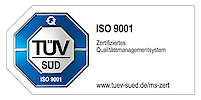Research
The scientific activity of the institute takes place in individual working groups and can be assigned to four subject areas:
- Laboratory diagnostics
- Viral Immunology / Immuno-oncology
- Circulating nucleic acids and therapeutic oligonucleotides
- Lipid and cholesterol metabolism
For more detailed information, please see the individual lab pages.
Our lab is focused on the participation of non-immune cells in innate immune sensing, both via activation of cell-intrinsic receptors and through crosstalk with professional immune cells. We would like to elucidate how non-myeloid somatic cells participate in the immune sensory system, both via direct innate immune sensing and in their capacity to influence traditional innate immune cells within the host. In another area of research, we are currently investigating the cell-intrinsic innate immune sensing in induced pluripotent stem-cell derived (iPSC) neurons. Our focus is on nucleic acid recognition in CNS-resident cells and its role in host defense.
Nucleic Acid Immunity & Genome Defense
We are intrigued by the question of how genetic material (DNA, RNA) can elicit an immune response and how this contributes to daily life immunity. In the past we focused on understanding the role of nucleic acid sensing-induced innate immune activation in the development of autoinflammatory and autoimmune diseases. During this work it has become clear that the same processes that cause pathologies in the diseased serve important physiological functions in healthy individuals, which we will try to understand in more detail. Specifically, we will study to role of endogenous viruses that occupy almost half our genomes in every cell of the body. Just for illustration, this means that almost every second letter in the written blueprint of our bodies is currently of viral origin. The activation of such endogenous viral sequences has been associated with different pathologies, including inflammatory diseases and cancer, as well as with ageing. We believe that a deeper understanding of this major fraction of our own genetic material holds the key to a better understanding of nucleic acid immunity in health and in disease. We are trying to develop our field of research by addressing the following three overarching questions:
- Under which conditions are endogenous nucleic acids immunogenic?
- How do endogenous viruses influence immunity?
- How can we therapeutically harness nucleic acid immunity?
Detection of foreign and harmful nucleic acids by the innate immune system is the central focus of research in the Hartmann lab. Fundamental discoveries about the function of RIG-I in sensing viral RNA has led to a robust program of research in this area and translation to clinical trials with the foundation of the start-up company Rigontec. In addition, the lab also investigates the mechanism and therapeutic potential of several other nucleic acid sensors, namely TLR7/8, TLR9, cGAS, and STING. With the help of the Clinical Study Center and the Central Laboratory of the institute, the lab’s basic research is transferred into clinical application.
Our lab focuses on how regulation of gene expression is directly executed by the ribosome, particularly in the innate immune response. Our lab studies a fundamentally new mode of gene regulation by which ribosomal RNA (rRNA) regions exposed on the outer shell of the ribosome bind to selective transcripts to control mRNA- and species-specific translation. We combine innovative RNA biochemistry and RNA-based technology development with model systems ranging from yeast to macrophages. Our ultimate goal is to decipher how rRNA-directed specialized translation shapes gene expression to understand the role of the ribosome in innate immune responses.
Environmental toxicants are an integral part of human life. As pollutants in the air we breathe, as pesticide and fertilizer residues in our food, or as soluble components in water bottles and plastic packaging. Accumulating evidence suggests that exposure to environmental toxicants not only inflicts adverse health effects in the exposed individual but can persist in subsequent unexposed generations through abnormal epigenetic modifications in germ cells, thereby causing adverse health effects like infertility, metabolic disorders and neurological changes in subsequent generations. However, despite progress in our general understanding of inheritable epigenetic modifications as a result of environmental exposures, their effects on immunity and host defense and consequent impact on multiple pathologies including cancer, microbial susceptibility, and autoimmune diseases across generations is severely understudied.
Our laboratory investigates the central hypothesis that ancestral environmental exposure causes epigenetic dysregulation that manifest in altered immune cell function, resulting in epigenetic inheritance of immune-mediated pathologies in unexposed, future generations. To test this hypothesis in detail, we will (i) characterize how environmental exposure causes inheritable epigenetic dysregulation in germ cells and (ii) examine how ancestral environmental experiences influence immune cell function.
The outcome of our studies will provide fundamental insights into how our immunological health was shaped by the environment of our ancestors and how we can adapt our environment today to protect the health of future generations.
For more than 30 years, our research has been focused on examining the metabolism of cholesterol and bile acids. We have developed diagnostic tools for the detection and monitoring of therapeutic interventions for rare hereditary disorders of cholesterol and bile-acid metabolism as well as diseases involving lipid pathophysiology. These extremely rapid analysis methods have made it possible to examine sterol metabolism on a cellular level as well as in vivo and ex vivo. Currently we are using these methods to study: atherosclerosis, neurodegenerative diseases, hepatic diseases, gastroenterologic disorders, and prenatal diagnostics.
The Paeschke group focuses its research on secondary DNA and RNA structures called G-quadruplex (G4). G4s are highly conserved in higher eukaryotes and enriched at functional genomic locations. The Paeschke laboratory is interested in the implications of G4 structures during the immune response, cellular stress, ageing and senescence and the overall interaction with G-quadruplex-binding proteins and the contribution to genome stability.
There are a number of research topics currently investigated in our laboratory.
We aim to reveal the function and regulation of G4 structures during Nucleotide Excision Repair (NER) of DNA breaks. We do have first indications of a connection of G4-triggered NER and skin cancer development.
We are analysing the impact of DNA and RNA helicases on G4 formation during the cellular stress response caused by infection or environmental changes. Special interest is the characterization of the helicase DHX36 function during viral stress.
We pursuit several projects exploring the contribution of G4 structure for the innate immune response. How does the cellular G4 landscape changes during inflammation and does this in turn triggers an immune response.
Members of the Paeschke laboratory also investigate viral G4s and how are they sensed by the host cell.
Finally, G4s are also present at telomeres, where they were first described and functionally analyzed by Katrin Paeschke in 2005. The Paeschke laboratory aims to determine G4-associated telomerase function within the genome and its contribution to genome stability and aging.
Find us on Twitter: @PaeschkeL
Our laboratory uses in vivo models to investigate anti-tumoral and anti-viral immune responses and exploits them to uncover novel immune boosting therapies. The pre-clinical translational aims of our research focus on discovering novel immunomodulatory repurposing candidates that reduce the deleterious effects of chronic viral infections and malignant tumors. For example, using an ex vivo screening strategy where T cells were co-cultured with tumor cells, we identified 5-Nonyloxytryptamine (5-NL), a serotonin agonist, as increasing the ability of T cells to target tumor cells through induction of MHC-I expression. Ultimately, we aim to boost the body’s immune system to counteract the effects of an immunosuppressive tumor microenvironment which often impedes immunotherapeutic treatment and supports tumor progression. Further integral to our work is dissecting how vaccine-induced immune training modulates the TME and the key components shaping its plasticity including myeloid infiltrating immune cells. Our work focuses on poorly immunogenic tumors including childhood leukemia due to the integral role that the untrained immune system plays in its initiation.
In our lab, the research is focused on studying the antiviral immune response of the innate immune system. This response is primarily initiated and regulated by host receptors that recognize viral nucleic acids. Our laboratory works on structures and modifications that lead to recognition by nucleic acid receptors or prevent detection of endogenous nucleic acids. The identification of minimal nucleic acid recognition motifs can be used to develop drugs for the immunotherapy of viral infections and cancer.
The Immune Monitoring & Genomic (IMG) Group (Schmidt laboratory) seeks to identify biomarkers and develop stratification systems for patients at risk for hyperinflammatory immune responses by using deep immune profiling approaches.
Our laboratory is set up to characterize immune responses on epigenetic, transcriptional and protein levels in the course of diverse inflammatory and rare diseases. We make use of in-house generated immunoassays to track immune responses to danger signals in whole blood, profile cytokine expression patterns using multiplexing bead-based assays and characterize the activation states of monocytes in peripheral blood by flow cytometry. Especially monocytes as major drivers of inflammation are of special interest, as we aim to elaborate molecular mechanisms of adaptive monocyte programming by bioinformatics analysis of transcriptional and epigenetics data.
Innate immune responses can be life-saving or life-threatening. Our group studies immune signaling pathways at the molecular and cellular level, for which we are developing new technologies like CRISPaint and in cellulo sequencing. Besides that, we work on algorithms to search for unknown diversity in sequencing data in order to characterize self-diversifying systems.
Each tissue site in the body has a distinctive immune network. By maintaining an active crosstalk with tissue components, immune cells exert their protective role and regulate tissue metabolism and function in homeostasis and disease. Our lab focuses on understanding how tissue-resident lymphocytes contribute to maintaining tissue function and shaping the tumor microenvironment metabolism and cellular composition. The lab works at the interface between tumor immunology and immunometabolism. Our ultimate goal is to identify key metabolic features supporting antitumor immunity, to provide new targets for the development of next generation therapies.
Our lab is focused on a unique group of immune cells, called innate lymphoid cells (ILC). We are trying to understand how these cells protect the body’s barrier sites, such as the lungs, skin, and gut but also how they cause immune pathology upon chronic activation. In particular, we aim to determine how exogenous and endogenous metabolites control the function of ILC in health and disease. Our ultimate goal is to understand the link between Westernization and the growing health problem of chronic inflammatory conditions such as inflammatory bowl disease (IBD) and asthma.
- Translational Immunology School
- Yearly meeting of the German Society for Experimental and Clinical Pharmacology and Toxicology (DGPT) German-Pharm-Tox-Summit
- Additional events and announcements of the Cluster of Excellence ImmunoSensation can be found here.

















